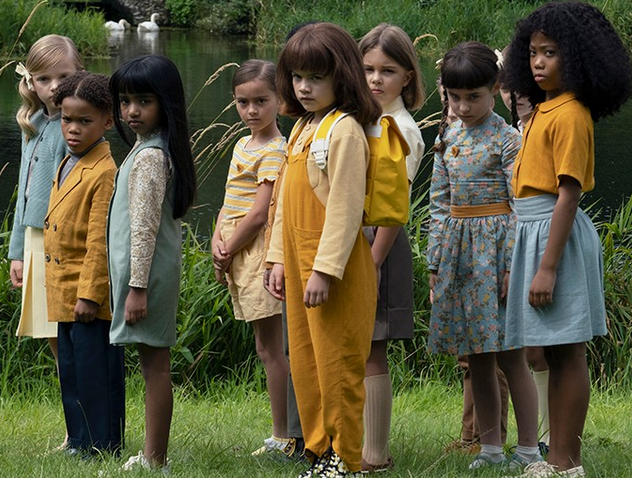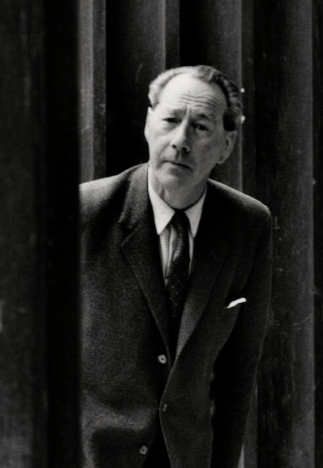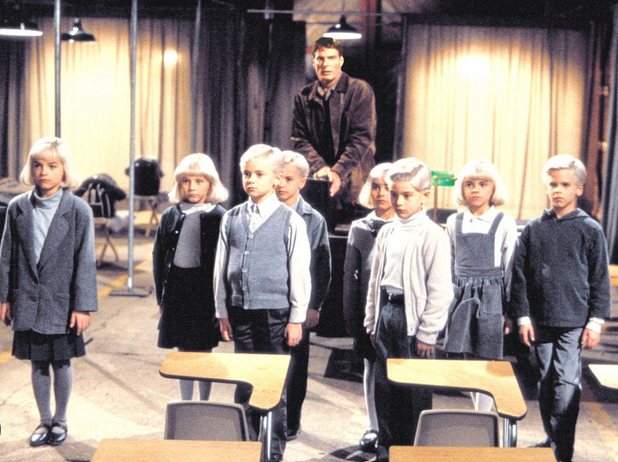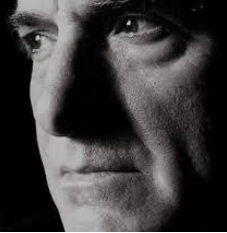
The smith that on his anvill the iron hard doth ding:
He cannot heare the cuckoo though he loud doth sing.
In poynting of plow harnesse, he labours till he sweat,
While another in his forge at home may steale a private heat.
—“The Cuckowes Comendation”, c. 1625
Despite a popular misconception, most cuckoo species build their own nests. But a significant minority—40 per cent—lay their eggs in the nests of other birds. This is known as brood parasitism. The cuckoo chicks are fed and raised by the host species. Sometimes the mother or builder of the nest recognises that the cuckoo egg doesn’t belong to her and pushes it out. Other times, the cuckoo mother will destroy whatever eggs are already in the host’s nest, leaving only her own.
The Midwich Cuckoos (2022) is a seven-episode television series, created by David Farr for Sky Max. It is directed by Alice Troughton, Jennifer Perrott and Borkur Sigporsson, stars Keeley Hawes, and is based on the 1956 novel by John Wyndham. It borrows liberally from the previous screen adaptations of the novel.
The premise of the original story, and the black-and-white masterpiece movie adaptation (below) made in 1960 called Village of the Damned, is that the entire fictional town of Midwich in southern England is cut off from the outside world by an unexplained event. No one can enter or leave. All eleven thousand residents, inside a clearly defined perimeter, have passed out. No communication with anyone inside is possible. Pilots attempting to fly over the town for reconnaissance instantly lose consciousness and crash.

When the mysterious force-field dissipates, every woman of child-bearing age in Midwich has become pregnant. None of the babies have been fathered by any of the men in the town. The children are all born at exactly the same time on the same day, with golden-orbed eyes and a hypnotic gaze that can compel others to do their bidding.
As the children mature, they develop a “hive-mind” or a shared communal consciousness—for example, something taught to one child is instantly learned by all. The children consider themselves a superior evolution of the human species.
Creating a contemporary seven-part series from an hour-and-a-half masterpiece from the 1960s requires some serious scriptwriting skill. This kind of thing was done extraordinarily well in the five-season series of Bates Motel (reviewed in the June 2021 Quadrant), based on the Alfred Hitchcock movie Psycho (also 1960). Many elements and characterisations of that new series were superior to Hitchcock’s original.
Unfortunately in The Midwich Cuckoos, this does not happen. The story has been padded out, diluting the concentrated power of both the original movie and the novel, while several opportunities to expand the story in fascinating ways were ignored.
The first episode begins with unexplained anxiety in all the farm animals and pets in the town. Horses break out of stables and birds fly in odd patterns. An ethereal purple haze hovers over Midwich. The town is cut off from the outside world by an invisible perimeter. Anyone crossing the line into the area immediately becomes unconscious. Soon people regain consciousness and it seems as if nothing unusual has happened, except for the deaths of a few villagers killed while driving motor vehicles at the time they became unconscious. This day is referred to as the DayOut.
Two months later, all the women of child-bearing age in the town are discovered to be pregnant, including several virgins. There are many accusations of infidelity and extramarital sex. Women who want to terminate their pregnancy are prevented from doing so by a psychological inability to follow through with their initial decision. The babies are all born with eyes that have bright yellow irises.
Two years later, while the precocious DayOut children are attending prep school, it is discovered they possess a psychic connection with each other. The children are taken to a government laboratory called Ward 300, which is under the supervision of Bernard Westcott. They begin to have recurring nightmares of being in a locked room, surrounded by a frozen landscape.
Investigation into their dreams uncovers a similar DayOut event that happened in Russia in 1973. The Russian children were lured by Soviet authorities into a locked school in a remote town in the middle of winter, and the school was bombed by an atomic missile, killing all of them.
Westcott takes some of the Midwich children to a military base for further tests. It is revealed that Westcott has the same golden irises as the children.
One of the children, Nathan Blake, discovers that when he is suffering extreme pain, it can block out the hive-mind of the other children. During one of these moments, he tells Dr Susannah Zellaby (played by Keeley Hawes), a child psychiatrist, that he no longer wants to be part of the group.
Westcott turns out to be the only survivor of the 1973 Russian children and he has been waiting forty years to locate another enclave. He believes that the Midwich residents cannot be trusted and initiates a plan for the children to leave for a more secure location, arranging a military bus to transport them. Dr Zellaby boards the bus with the children, carrying a hidden explosive device. Just outside the town, the bomb is detonated, killing her and everyone else on the bus. But Westcott and one of the children, Nathan, survive the explosion.
“John Wyndham” was the main pseudonym of the British writer John Wyndham Parkes Lucas Beynon Harris, who was born in 1903 in Birmingham. He is best known for four science-fiction novels, The Day of the  Triffids (1951), The Kraken Wakes (1953), The Chrysalids (1955) and The Midwich Cuckoos (1957).
Triffids (1951), The Kraken Wakes (1953), The Chrysalids (1955) and The Midwich Cuckoos (1957).
Wyndham (left) began writing for money under several pen-names in 1925. He served during the Second World War as a censor in the Ministry of Information, as a firewatcher during the London Blitz, as a member of the Home Guard, as a corporal cipher operator in the British Army Royal Corps of Signals, and he participated in the Normandy landings. He was a member of XXX Corps which surrounded the German army in the Battle of the Falaise Pocket, the decisive engagement of Normandy, under Allied ground forces commander General Bernard Montgomery.
In an article in the November 2014 Quadrant, “Triffids, Daleks and the Fragility of Civilisation”, the Melbourne art historian and cultural critic Christopher Heathcote wrote:
John Wyndham wrote with a distinctively English voice. It is recognisable in his diction, his choice of phrasing, as well as the moral outlook his narrators verbalise, their sense of what constitutes decency. All four Wyndham books are now classified as science fiction, but this was not the case when The Day of the Triffids appeared in 1953, the genre then being identified with space adventures and high-tech futuristic fantasies. Instead the novel’s roots in the surrealist and neo-romantic imagery of the war years were apparent.
In the novel The Midwich Cuckoos it is never established that the black-out event in Midwich is caused by an alien visitation. There is the suggestion that it could possibly be an evolutionary anomaly. From the first page of the novel, the roads into town are closed to outsiders, immediately establishing tension. In contrast, the new series takes twenty-five slow minutes into the first episode before we get to this point.
Sixty-one women become pregnant. Wyndham writes:
All these sixty-one golden-eyed children we have here are intruders, changelings: they are cuckoo-children. Now the important thing about the cuckoo is not how the egg got into the nest, nor why that nest was chosen. The real matter for concern comes after it has been hatched—what, in fact, it will attempt to do next. And that, whatever it may be, will be motivated by its instinct for survival, an instinct characterised by utter ruthlessness.
The pregnant women are the “host mothers, rather than the true mothers”.
Later in the book, influenza kills three of the children—a vulnerability not included in any of the film adaptations.
In the book, there is not a single group mind—as in the films—but two separate entities. The boys have one hive-mind and the girls have another: a solution to a complex puzzle-box is shown to one boy and all the boys instantly know the solution, but not the girls; one girl has to be shown before all the girls have learned it. Wyndham writes, “One talks with either the Composite Boy or the Composite Girl … the children do not have individual spirits—they have one man-spirit and one woman-spirit.”
In the book, there had been four previous occurrences of this kind of unexplained impregnation and birth of hive-children. In the Northern Territory there were thirty-three pregnancies but all the children died. In a Canadian Eskimo settlement on Victoria Island, all the children were immediately exposed on the ice and none survived. In the Irkutsk region, near Outer Mongolia, the men believed the “women had been lying with devils” and the children and their mothers were killed. In Gizhinsk, north-east of Okhotsk, Russia, the week before Midwich, the shell of an atomic cannon obliterated the entire village. There is also a suggestion in the novel that there could be more hive-groups in South America and Africa.
Wyndham suggests that “no solution is morally defensible” as to whether the children should be allowed to live—possibly endangering the entire human race—or should be destroyed. He reminds us that our culture has “scruples about the ruthless liquidation of unarmed minorities”, although he certainly is mistaken here about the children being unarmed. He concludes, perhaps from some hard lessons learned in the Second World War: “in a quandary where every course is immoral, there still remains the ability to act for the greatest good of the greatest number”.
The original film, Village of the Damned (below), was directed by Wolf Rilla and released by MGM in 1960. Its pacing is brisk and quintessentially British at the same time. The no-go perimeter is five miles around the town and the villagers remain unconscious for four hours. All the babies are born with beautiful platinum blonde hair and narrow fingernails. Although the movie was filmed in black-and-white, the golden hair and radiating golden irises of the children are perfectly represented through the extraordinary cinematography, effects and sharp dialogue.

Professor Zellaby’s wife, Anthea, gives birth to one of the children, a boy named David. At three years old, the children have the mental capability of twelve-year-olds and can read minds. They dress identically and always walk together as a group. Several deaths of locals are attributed to the children’s influence but no one can prove anything. When David confesses to Zellaby that they are responsible for the deaths because they must continue to protect themselves at any cost, a decision is made to destroy the children.
Zellaby suggests to David that if they relocate to a separate dedicated schoolhouse, away from the villagers, they can learn at their own pace. The children agree. But Zellaby brings a time-bomb with him into the schoolroom, hidden in his briefcase and manages, through force of will, to prevent the children from reading his mind. The bomb explodes, killing everyone in the building.
A poor sequel was made in 1964 called Children of the Damned. The script by John Briley has nothing to do with the Wyndham novel. There is no explanation of where the children came from—the sequel assumes we already know the backstory. Somehow—it isn’t explained—they arrive in London from six countries for a study on their collective intelligence. They escape from their housing and meet together secretly at an abandoned church. A study of their blood cells indicates that they are non-human but one scientist suggests they are, in fact, humans, only advanced by a million years, and not of alien origin. The children reach a decision that they are not compatible with the existing human race and sacrifice themselves by allowing the army to destroy them in an attack on the church.
In 1995, director John Carpenter re-imagined the original Village of the Damned story in contemporary Marin County, California. The people of Marin black out for six hours. Ten women become pregnant, giving birth to five boys and five girls, but one of the girls is stillborn. The children all have the distinctive white-blond hair and penetrating eyes. They form pairs, except for David, whose partner was stillborn. David’s mother is the local school principal, Jill McGowan. He becomes the black sheep of the group and the only child showing human compassion.
As the children grow older, they develop a dangerous side that threatens the community so they move into a local barn, living communally. All the children are killed in a bomb explosion at the barn except David, who escapes with his mother. Christopher Reeve (below with his cuckoos) appears as the town doctor, Alan Chaffee, who is responsible for taking the bomb into the barn. It was Reeve’s last film before the 1995 horse riding accident which left him a paraplegic.

The British science fiction writer Brian Aldiss called Wyndham’s novels “cosy catastrophes”. Other writers have labelled Wyndham “the master of the middle-class catastrophe”. But britannica.com hails Wyndham as a writer “who examined the human struggle for survival when catastrophic natural phenomena suddenly invade a comfortable English setting”. Christopher Heathcote described the novels as “sounding boxes for Cold War unease”.
Clifford Stoll is an American astronomer and teacher. In 1989, while working as a systems administrator, he wrote a book, The Cuckoo’s Egg: Tracking a Spy Through the Maze of Computer Espionage, about a German hacker, KGB recruit Markus Hess, who broke into the Lawrence Berkeley National Laboratory computers, pirating accounts (installing malware, or “cuckoo eggs”) in an attempt to breach US military security. Stoll set ingenious traps and eventually tracked Hess down, leading to his arrest. It was one of the first successful examples of digital forensics.
The Midwich Cuckoos series is worth a watch, especially for fans of the book, just to see how contemporary film-makers tell this unique sci-fi story.
But the writers of the series missed an opportunity to expand on the briefly mentioned instances of the previous blackouts in Australia, Canada, Outer Mongolia and Russia. It would have made much more compelling viewing to see the stories of the children’s previous unsuccessful attempts to colonise, than to rehash the same old story again.
As with the Frankenstein, Mummy and Dracula tales, and the 1951 sci-fi classic The Day the Earth Stood Still and other films of the period, which have all been subject to some woeful retellings, sometimes the original version is the best.
 Sign In
Sign In 0 Items (
0 Items ( Search
Search









Reading this piece, I was reminded of Ross Douthat’s book “The Decadent Society” in which he argues that the West has entered a period of cultural stagnation and exhaustion. This can be seen in the repetitions of our pop culture and how Hollywood keeps rehashing old material and making the same movies and tv shows over and over again. The key differences between the old and new versions is that the newer offerings are often dumbed down, coarser, infused with contemporary woke themes, and are obliged to have a far more racially diverse cast.
In the first few paragraphs , I was thinking this article was going to be a metaphor and repudiation of Dan Andrews’ Victoria !
For Adam Bandt, it might be called The Greenwich Cuckoo Clocks.
I reckon I’m with you on this one, Joe. I watched this adaption earlier this year, and it wasn’t until I was about three paragraphs in that I suddenly remembered I had already seen it and forgotten about it. There are some excellent re-imaginings of old stories (Perry Mason, for instance) but this ain’t one.